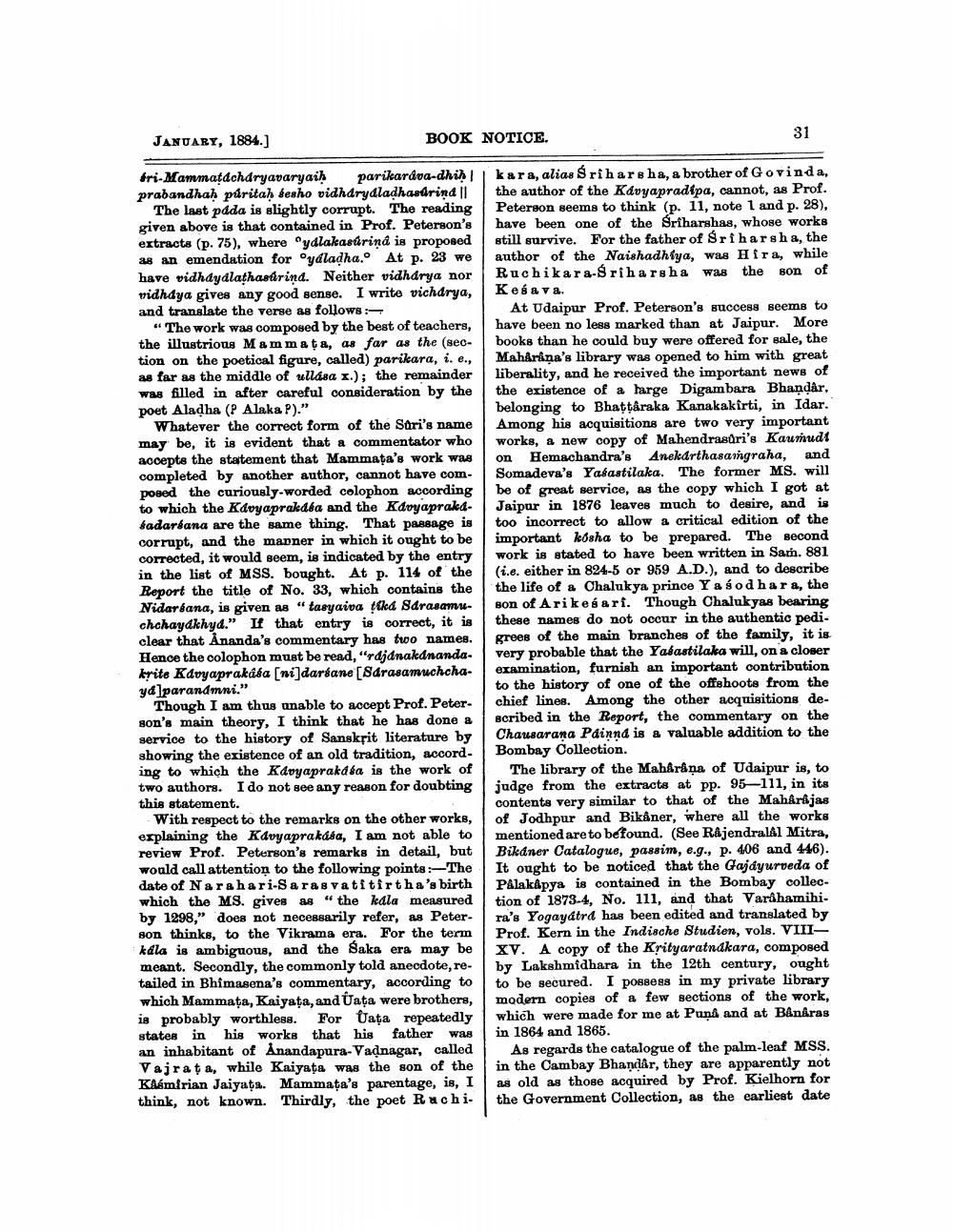________________
JANUARY, 1884.)
BOOK NOTICE.
31
fri-Mammațdcharyavaryaih parikardua-dhih prabandhah puritah kesho vidhdrydladhasdrind II
The last pdda is slightly corrupt. The reading given above is that contained in Prof. Peterson's extracts (p. 75), where ydlakasurind is proposed 28 an emendation for Cydladha.° At p. 23 we have vidhdydlathastrind. Neither vidhdrya nor vidhdya gives any good sense. I writo vichdrya, and translate the verse as follows:
“The work was composed by the best of teachers, the illustrious Mamma ţa, as far as the (section on the poetical figure, called) parikara, i. e., as far as the middle of ullása x.); the remainder was filled in after careful consideration by the poet Aladha (P Alaka P)."
Whatever the correct form of the Sari's name may be, it is evident that a commentator who accepts the statement that Mammaţa's work was completed by another author, cannot have composed the curiously-worded colophon according to which the Kdoyaprakdba and the Kdoyaprakdkadarlana are the same thing. That passage is corrupt, and the manner in which it ought to be corrected, it would seem, is indicated by the entry in the list of MSS. bought. At p. 114 of the Report the title of No. 33, which contains the Nidarsana, is given as "tasyaiva tika Sdrasamachchaydkhyd." If that entry is correct, it is clear that Ananda's commentary has two names. Hence the colophon must be read,"rdjdnakdnandakrite Kdvyaprakása (ni]darsane (Sarasamuchchaydparandmni."
Though I am thus unable to accept Prof. Peterson's main theory, I think that he has done a service to the history of Sanskrit literature by showing the existence of an old tradition, according to which the Kdoyaprakába is the work of two authors. I do not see any reason for doubting this statement.
With respect to the remarks on the other works, explaining the Kavyaprakása, I am not able to review Prof. Peterson's remarks in detail, but would call attention to the following points :-The date of Narahari-Sarasvatitirtha's birth which the MS. gives as “the kala measured by 1298," does not necessarily refer, as Peter son thinks, to the Vikrama era. For the term kdla is ambiguous, and the Saka era may be meant. Secondly, the commonly told anecdote, retailed in Bhimasena's commentary, according to which Mammata, Kaiyata, and Uata were brothers, is probably worthless. For taţa repeatedly states in his works that his father was an inhabitant of Anandapura-Vadnagar, called Vajrat a, while Kaiyaţa was the son of the Kaśmfrian Jaiyata. Mammața's parentage, is, I think, not known. Thirdly, the poet Rachi
kara, alias Sriharsha, a brother of Govinda, the author of the Kavyapradipa, cannot, as Prof. Peterson seems to think (p. 11, note 1 and p. 28), have been one of the Sriharshas, whose works still survive. For the father of Sriharsha, the author of the Naishadhiya, was Hira, while Ruchikara-Sriharsha was the son of Kesava.
At Udaipur Prof. Peterson's success seems to have been no less marked than at Jaipur. More books than he could buy were offered for sale, the Mahårina's library was opened to him with great liberality, and he received the important news of the existence of a large Digambara Bhandar, belonging to Bhattaraka Kanakakirti, in Idar. Among his acquisitions are two very important works, a new copy of Mahendrasuri's Kaumudt on Hemachandra's Anekdrthasangraha, and Somadeva's Yasastilaka. The former MS. will be of great service, as the copy which I got at Jaipur in 1876 leaves much to desire, and is too incorrect to allow a critical edition of the important kósha to be prepared. The second work is stated to have been written in Sam. 881 (i.e. either in 824-5 or 959 A.D.), and to describe the life of a Chalukya prince Y a sodhara, the son of Arikesari. Though Chalukyas bearing these names do not occur in the authentic pedi. grees of the main branches of the family, it is very probable that the Yasastilaka will, on a closer examination, furnish an important contribution to the history of one of the offshoots from the chief lines. Among the other acquisitions described in the Report, the commentary on the Chausarana Páinnd is a valuable addition to the Bombay Collection.
The library of the Mahârâņa of Udaipur is, to judge from the extracts at pp. 95-111, in its contents very similar to that of the Maharajas of Jodhpur and Bikaner, where all the works mentioned are to be found. (See RajendralAl Mitra, Bikaner Catalogue, passim, e.g., p. 406 and 446). It ought to be noticed that the Gajdyurveda of PAlakäpya is contained in the Bombay collection of 1873-4, No. 111, and that Varahamihi. ra's Yogayatrd has been edited and translated by Prof. Kern in the Indische Studien, vols. VIIIxv. A copy of the Krityaratndkara, composed by Lakshmidhara in the 12th century, ought to be secured. I possess in my private library modern copies of a few sections of the work, which were made for me at Punâ and at Banaras in 1864 and 1865.
As regards the catalogue of the palm-leaf MSS. in the Cambay Bhandar, they are apparently not as old as those acquired by Prof. Kielhorn for the Government Collection, as the earliest date




